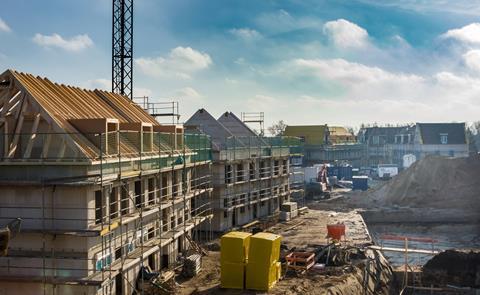Ministers unleashed a barrage of planning reforms in the dying days of 2024. Joey Gardiner asks if these can give the industry the boost it needs to get anywhere close to the government’s ambitious housebuilding target?

The new government is in something of a hole over housing. It has around four and a half years in which to build the 1.5 million houses that Keir Starmer has promised and, by common consent – indeed by the housing secretary’s own admission – net additions of new homes are likely to fall to around 200,000 this year. That’s way off target.
More than that, the volume of planning applications being submitted and granted is as low as it has been for at least a decade, with official statistics showing the number of major planning permissions granted in the year to April 2023 at 42% below the 2016/17 peak. According to research by data firm Glenigan for the Home Builders Federation (HBF), permission for just 230,000 homes was granted in the year to June 2024 – way below what housebuilders believe would be necessary to build at or above the 300,000 homes per year targeted.
It is into this bleak winter backdrop, then, that Labour ministers delivered the industry a veritable bulging Christmas stocking full of planning policy gifts in the run-up to the festive break.
Housing secretary Angela Rayner said the reforms, which included finalising national planning policy alterations and setting out a series of other proposed changes, were a “landmark overhaul” designed to achieve the build target by “shak[ing] up a broken planning system which caves into the blockers and obstructs the builders”.
Hitting back, the Conservatives said in the House of Commons that the plans would see the “bulldozing [of] democratic accountability” and the “concreting over green belt, green fields and over our green and pleasant land”.
Labour is relying on this package to get the industry from its current state to historically unprecedented levels of homebuilding in less than a parliament. To stand any chance of hitting its target, a huge spike in applications and approvals will be needed – and in short order. But, even if that happens, many questions remain about what else will be needed to turn permissions into real homes.
Buoyant
For many in the sector, the reforms, promised before the election, have done what they said on the tin. Matthew Spry, senior director at planning consultant Lichfields, says that, taken in the round, they are a “game changer”. Paul Campbell, chief executive of land promoter Richborough, says, with some satisfaction: “Labour have done what they said they’d do. It’s a massive step forward.”
The final version of the National Planning Policy Framework (NPPF) emerged last month amid a flurry of proposals, including to shake up the planning committee system, reintroduce strategic planning, sort the nutrient neutrality blockage and free up the public sector to compulsorily purchase land for homes (see below, “NPPF – main changes and Further planning reform proposals”).
Many in the sector see the finalised NPPF as not only a huge improvement on the version brought in by Michael Gove in December 2023, but also as incrementally more pro-development than the proposals consulted upon by ministers after Labour was elected in July. Richborough’s Campbell says they are a “small net positive” on the July iteration.

“The land sector will have gone into the Christmas break in buoyant mood after this,” says Sam Stafford, policy director at trade body the Home Builders Federation (HBF).
Green belt game changer
For Lichfields’ Spry it is the combination of measures – the effect of which is to increase the number of authorities vulnerable to speculative applications, while at the same time reducing, via the introduction of the new “grey belt” classification, the blanket protection that green belt areas have had from development – that is powerful. This should incentivise authorities even in green belt areas to bring forward plans.
“In combination with the new standard method, and the reintroduction of provisions around five-year land supply, the provisions on grey belt are a game changer,” Spry says.
“Until the new NPPF, there were 180 planning authorities where green belt release via planning application was impossible in all but the rarest of cases, providing no incentive for many of them to prepare a local plan.”
National Planning Policy Framework – main changes
- The “standard method” for determining local housing need in individual authorities has been revised to deliver a nominal housing target of 370,000 homes across England, up from around 300,000 previously, with meeting the target made mandatory in most cases. The algorithm has been tweaked since the July proposal to take more account of affordability, with the result that more of the 370,000 homes are required in London and the South-east.
- Local authorities will once again have to demonstrate a five-year land supply, even when they have in-date plans. In a new policy introduced since the July consultation, councils will have to demonstrate an extra 20% on top of the five-year supply from July 2026 if they have a local plan based on the old numbers, where the housing target is less than 80% of the new assessment of need
- Local authorities will be required to undertake green belt reviews where they do not have enough land to meet housing need, prioritising previously developed and then “grey belt” sites
- The NPPF introduces a new concept of grey belt sites, with the definition tweaked since the July proposal, to mean sites within the green belt that have not been previously developed but do not contribute “strongly” to three of the green belt purposes (leaving out countryside encroachment). Building on such sites in specific circumstance is not deemed “inappropriate development” in the green belt and therefore does not need to demonstrate exceptional circumstances
- Any development on green belt must follow “golden rules”, by delivering extra affordable housing, local infrastructure and local green space provision. In a change to the July proposal, the requirement for a flat 50% affordable housing rate has been dropped in favour of applicants offering 15 percentage points above local plan requirements – up to a 50% cap. Viability negotiations are ruled out.
- The NPPF applies from now for decision-making and from 12 March this year for plan-making, with transitional arrangements setting out that councils that have submitted a plan for examination or reached a regulation 19 consultation stage on a local plan by then are able to carry on with it, so long as the housing target is 80% or more of the newly assessed need.
Planning consultant Catriona Riddell, who has been advising the government on its reform package, says green belt authorities are now at “much higher risk” from speculative applications. “I think they will move pretty quickly to get plans in place,” she says.
At the same time, the final document has removed the threat of a flat-rate 50% affordable housing requirement on green belt sites, which many in the development sector had argued would make most unviable. Instead, green belt sites (such as those coming forward under the new “grey belt” designation) will have to deliver 15 percentage points more affordable housing than what is required in the local plan – a solution only five percentage points above the 10 percentage point premium the development industry itself had argued for.
Paul Smith, managing director of land promoter Strategic Land Group, says: “What’s five [percentage points] between friends? There may be some sites that won’t come forward, but overall, this is a much more sensible and pragmatic solution.”
Further planning reform proposals
In addition to publishing the finalised text of the NPPF, the government also published the following planning reform proposals in December:
- Planning committees: In a working paper the Ministry of Housing, Communities and Local Government (MHCLG) said it wanted to introduce a national scheme of delegation that will see a much larger proportion of decisions made by planning officers than by committee of elected members. It laid out three options for how this might work and also proposed smaller “strategic” planning committees and better training for members.
- Nutrient neutrality: A working paper on development and nature recovery, published by the ministry, set out plans that will see a public delivery body take on the job of developing schemes to mitigate nutrient pollution, with affected developers funding this via a “nature restoration fund”.
- Strategic planning: The MHCLG’s English devolution white paper, which set out plans to shake up the delivery of local government in England, also included proposals for “mandatory” and “universal” strategic plans across the country. Ultimately these plans, to be drawn up largely by combined authorities or county councils, will determine how many homes each authority in their area has to take.
- Compulsory purchase: The ministry published a consultation on further reforms to the way the system of compulsory purchase orders (CPOs) works, designed to make the new CPO process outlined under the Levelling Up and Regeneration Act – which allows for the removal of “hope value” from CPO payments where there is public interest – more efficient.
Highly appealing
There are signs too that it could prompt the resurgence in planning applications that will be vital if the government is to hit its targets. Paul Campbell says Richborough has doubled its headcount and submitted applications for around 7,500 plots last year, more than twice the volume of development it has submitted in any previous year, with this expansion a direct result of the government’s reform programme. In 2025, he says, he expects the number of plots applied for to rise even further to 10,000-15,000.
“We prepared a series of applications ready for the change in government,” he says. “We specifically geared up for this policy change and I think others are too – I think there will be a significant increase in applications.”
The changes will help bring forward more land in the most sustainable locations, namely grey belt sites on the edge of cities
Philip Barnes, group planning director at housebuilder Barratt Redrow
The HBF’s Stafford, likewise, says he expects that housebuilder land managers will now be instructing their teams to finalise assessments on green belt sites. Lichfields’ Spry says the new grey belt route means there should – at least in theory – be sufficient land that 75,000 to 100,000 extra homes a year are able to come forward in green belt local authorities.
As part of this, Philip Barnes, group planning director at housebuilder Barratt Redrow, says the change to the golden rule proposal around a 50% affordable housing take was particularly welcome. “The changes will help to bring forward more land in the most sustainable locations, namely grey belt sites on the edge of cities,” he says.
In addition, he says that the proposal to streamline planning committees, if taken forward via the forthcoming planning and infrastructure bill, could be “very significant”. The measures, which propose getting planning officers to take the vast majority of decisions, could “much reduce the costs and risks associated with bringing forward housing schemes on sites allocated for housing in the local plan”, he says.
Here’s the rub
But nothing is ever simple. The big concern in the housebuilding sector is over how much time this will all take to bed in. While the new NPPF takes effect straight away for the purposes of decision-making, for plan-making the transitional arrangements give councils three months’ leeway to reach the regulation 19 consultation stage on draft plans drawn up under the previous system – much longer than originally proposed.
This means that, if authorities can rush out a local plan consultation against the previous housing targets before 12 March, they can potentially get a plan in place on lower housing numbers which means they will not have to plan against the new housing target for another five years. While there are some protections that kick in where numbers are particularly low, some are concerned these transitional arrangements will effectively stop the policy from taking effect.
Planning barrister Zack Simons, of Landmark Chambers, described the transitional arrangements in December as “baking in very much lower housing numbers” than the level of need calculated under the new standard method. To get to 1.5 million homes, he said, “these so-called mandatory numbers need to get an awful lot more mandatory much, much quicker”.
SLG’s Smith agrees, arguing that the ability of authorities to “self-declare” that they have reviewed their plans as up to date will at the same time protect many from any speculative applications that come in being judged against the presumption in favour of sustainable development that is elsewhere in the NPPF.
>>See also: The new NPPF: the time for waiting is over
>>See also: Updated National Planning Policy Framework explained
“I don’t think the transitional arrangements get you to the new housing need target quickly enough to get to 1.5 million in the life of a parliament. The fact of the matter is there’s still no chance,” he says.
“It will be five years before the whole country is required to plan for these numbers [in the standard method].”
The situation is not helped by the fact that changes to the wording of the presumption in favour of development itself look to have made its effect slightly weaker by introducing a series of key policies which need to be considered when applying it. “The looser you are with the transitional arrangements on local plans, then the firmer you need to be with the presumption,” says Sam Stafford. “But, if anything, this has been weakened.”
Delivery test
All of which is in addition to the fact that planning is just part of the problem to be solved if the government wants to see its 1.5 million target hit. Producing planning permissions does not ensure that homes get built, particularly in a market when the construction of thousands of homes is held up waiting for housing association buyers for the affordable element.
Neil Jefferson, chief executive of the HBF, said after the NPPF was published that housing demand was currently “suppressed” by housing associations’ lack of capacity to buy up stock, and by the “lack of affordable mortgage lending and support for first-time buyers”. He added: “Further policy interventions are needed if we are to meet the ambitious target.”
The planning reforms are a great foundation. But unless the government invests financially to back a long-term plan for housing, we won’t meet the 1.5 million target.
Marie Chadwick, policy leader, National Housing Federation
According to housing association trade body the National Housing Federation (NHF), a long-term rent settlement for the sector, which promises to make up for past rent reductions, plus annual grant funding of £4.6bn to pay for 90,000 homes per year is necessary to re-capitalise associations and get them building again.
Marie Chadwick, policy leader at the NHF, says: “The planning reforms are a great foundation. But unless the government invests financially to back a long-term plan for housing, we won’t meet the 1.5 million target. The message is the same whoever you speak to.”
Any sense of whether this government is willing to make the funding commitments, either with social housing or first-time buyer support to help turn planning permissions into homes, will come at the spending review – currently scheduled for “late spring” this year. In the meantime, consultant Catriona Riddell says the ball is in the industry’s court.
“The housebuilders have got everything they wanted in terms of policy,” she says. “I think that, rather than complaining about the transitional arrangements, which do prompt authorities to review where numbers are low, housebuilders have got to deliver now.
“It is time for the sector to step up.”



























No comments yet